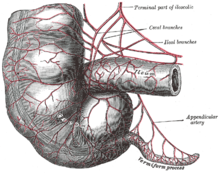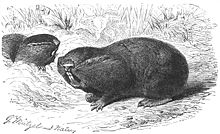https://en.wikipedia.org/wiki/Heteroplasmy
Heteroplasmy is the presence of more than one type of organellar genome (mitochondrial DNA or plastid DNA) within a cell or individual. It is an important factor in considering the severity of mitochondrial diseases. Because most eukaryotic cells contain many hundreds of mitochondria with hundreds of copies of mitochondrial DNA, it is common for mutations to affect only some mitochondria, leaving most unaffected.
Although detrimental scenarios are well-studied, heteroplasmy can also be beneficial. For example, centenarians show a higher than average degree of heteroplasmy.
Microheteroplasmy is present in most individuals. This refers to hundreds of independent mutations in one organism, with each mutation found in about 1–2% of all mitochondrial genomes.
Heteroplasmy is the presence of more than one type of organellar genome (mitochondrial DNA or plastid DNA) within a cell or individual. It is an important factor in considering the severity of mitochondrial diseases. Because most eukaryotic cells contain many hundreds of mitochondria with hundreds of copies of mitochondrial DNA, it is common for mutations to affect only some mitochondria, leaving most unaffected.
Although detrimental scenarios are well-studied, heteroplasmy can also be beneficial. For example, centenarians show a higher than average degree of heteroplasmy.
Microheteroplasmy is present in most individuals. This refers to hundreds of independent mutations in one organism, with each mutation found in about 1–2% of all mitochondrial genomes.
Types of heteroplasmy
In order for heteroplasmy to occur, organelles must contain a genome and, in turn, a genotype. In animals, mitochondria
are the only organelles that contain their own genomes, so these
organisms will only have mitochondrial heteroplasmy. In contrast,
photosynthetic plants contain mitochondria and chloroplasts, each of which contains plastid genomes. Therefore, plant heteroplasmy occurs in two dimensions.
Organelle inheritance patterns
In 1909, while studying chloroplast genomes, Erwin Baur made the first observations about organelle inheritance patterns. Organelle genome inheritance differs from nuclear genome, and this is illustrated by four violations of Mendel's laws.
- During asexual reproduction, nuclear genes never segregate during cellular divisions. This is to ensure that each daughter cell gets a copy of every gene. However, organelle genes in heteroplasmic cells can segregate because they each have several copies of their genome. This may result in daughter cells with differential proportions of organelle genotypes.
- Mendel states that nuclear alleles always segregate during meiosis. However, organelle alleles may or may not do this.
- Nuclear genes are inherited from a combination of alleles from both parents, making inheritance biparental. Conversely, organelle inheritance is uniparental, meaning the genes are all inherited from one parent.
- It is also unlikely for organelle alleles to segregate independently, like nuclear alleles do, because plastid genes are usually on a single chromosome and recombination is limited by uniparental inheritance.
There
is a wide variety of mitochondrial DNA genotypes in the maternal pool,
which is represented by the bottle. The two genotypes in this maternal
pool are represented by blue and yellow. When generated, each oocyte
receives a small subsampling of mitochondrial DNA molecules in differing
proportions. This is represented by the conveyor belt with oocytes,
each one unique, as they are produced.
Vegetative segregation
Vegetative segregation,
the random partitioning of cytoplasm, is a distinguishable
characteristic of organelle heredity. During cell division, the
organelles are divided equally, providing each daughter cell with a
random selection of plasmid genotypes.
Uniparental inheritance
Uniparental
inheritance refers to the fact that, in most organisms, many offspring
inherit organelle genes from only one parent. However, this is not a
general law. Many organisms that have the ability to differentiate
maternal and paternal sexes will produce offspring with a mixture of
maternal, paternal, and biparental mitochondrial DNA.
Mitochondrial bottleneck
Entities undergoing uniparental inheritance and with little to no recombination may be expected to be subject to Muller's ratchet,
the inexorable accumulation of deleterious mutations until
functionality is lost. Animal populations of mitochondria avoid this
buildup through a developmental process known as the mtDNA bottleneck.
The bottleneck exploits stochastic processes in the cell
to increase in the cell-to-cell variability in mutant load as an
organism develops: a single egg cell with some proportion of mutant
mtDNA thus produces an embryo where different cells have different
mutant loads. Cell-level selection may then act to remove those cells
with more mutant mtDNA, leading to a stabilisation or reduction in
mutant load between generations. The mechanism underlying the bottleneck
is debated,
with a recent mathematical and experimental metastudy providing
evidence for a combination of random partitioning of mtDNAs at cell
divisions and random turnover of mtDNA molecules within the cell.
The mitochondrial bottleneck concept refers to the classic evolutionary term,
which is used to explain an event that reduces and specifies a
population. It was developed to describe why mitochondrial DNA in an
embryo might be drastically different from that of its mother. When a
large population of DNA is subsampled, each sample population will
receive a slightly different proportion of mitochondrial genotypes.
Consequently, when paired with a high degree of replication, a rare or
mutated allele can begin to proportionally dominate. In theory, this
makes possible a single-generation shift of overall mitochondrial
genotype.
Selection
Although it is not well characterized, selection can occur for organelle genomes in heteroplasmic cells. Intracellular
("within cells") selection occurs within individual cells. It refers to
the selective segregation of certain genotypes in mitochondrial DNA
that allows the favoured genotype to thrive. Intercellular ("between
cells") selection occurs on a larger scale, and refers to the
preferential growth of cells that have greater numbers of a certain
mitochondrial genotype.
Selective differences can occur between naturally occurring,
non-pathological mtDNA types when mixed in cells, and may depend on
tissue type, age, and genetic distance. Selective differences between naturally occurring mtDNA types may pose challenges for gene therapies.
In mitochondrial DNA, there is evidence for potent germline purifying selection, as well as purifying selection
during embryogenesis. Additionally, there is a dose-dependent decrease
in reproduction ability for females that have mutations in mitochondrial
DNA. This demonstrates another selection mechanism to prevent the
evolutionary preservation of harmful mutations.
Reduced recombination
It
is very rare for organelle genes from different lineages to recombine.
These genomes are usually inherited uniparentally, which does not
provide a recombination
opportunity. If they are inherited biparentally, it is unlikely that
the organelles from the parents will fuse, meaning they will not share
genomes.
However, it is possible for organelle genes from the same lineage
to recombine. Intramolecular and intermolecular recombination can cause
inversions and repeats in chloroplast DNA, and can produce subgenomic
circles in mitochondrial DNA.
Mitochondrial mutations in disease
Mutations in mitochondrial DNA are usually single nucleotide substitutions, single base insertions, or deletions.
Because each cell contains thousands of mitochondria, nearly all
organisms house low levels of mitochondrial variants, conferring some
degree of heteroplasmy. Although a single mutational event might be rare
in its generation, repeated mitotic segregation and clonal expansion
can enable it to dominate the mitochondrial DNA pool over time. When
this occurs, it is known as reaching threshold, and it usually results
in physiological consequences.
Severity and time to presentation
Symptoms
of severe heteroplasmic mitochondrial disorders do not usually appear
until adulthood. Many cell divisions and a great deal of time are
required for a cell to accumulate enough mutant mitochondria to cause
symptoms. An example of this phenomenon is Leber optic atrophy.
Generally, individuals with this condition do not experience vision
difficulties until they have reached adulthood. Another example is MERRF syndrome (or Myoclonic Epilepsy with Ragged Red Fibers). In MELAS, heteroplasmy explains the variation in severity of the disease among siblings.
Screening
Preimplantation genetic screening
(PGS) can be used to quantitate the risk of a child of being affected
by a mitochondrial disease. In most cases, a muscle mutation level of
approximately 18% or less confers a 95% risk reduction.
Sequence illustrating heteroplasmy genotype of 16169 C/T in Nicholas II of Russia.
Notable cases
One notable example of an otherwise healthy individual whose heteroplasmy was discovered incidentally is Nicholas II of Russia, whose heteroplasmy (and that of his brother) served to convince Russian authorities of the authenticity of his remains.












